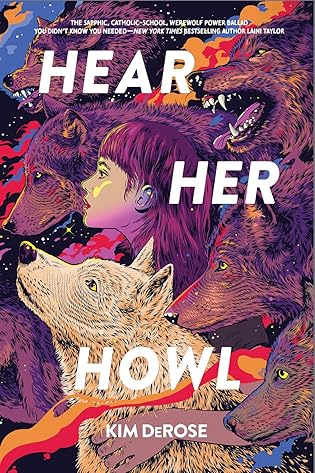
Author Interview: Hear Her Howl by Kim DeRose
Kim DeRose’s Hear Her Howl sinks its claws into girlhood, hunger, and the holy hush of secrets kept behind convent walls, then lets them out to run wild under a blood moon. We chatted with Kim about what it means to turn the “good girl” myth inside out, how werewolves can be a reclamation instead of a curse, and the playlist you’ll want on repeat when the pack finally breathes free. Check it out below and pick up Hear Her Howl, out November 4th!

Hear Her Howl
by Kim DeRosePublished by: Union Square and Co
on November 4th, 2025
Genres: LGBTQIA+, Speculative Fiction, Young Adult
Bookshop
Goodreads
As fiercely feminist as it is hopeful, this speculative, sapphic YA romance is simultaneously a modern-day war cry and a PSA that there is a wolf who slumbers us all—we only have to wake her.
Rue’s life is over. After she’s caught kissing a girl behind the Sunday School classrooms, she gets exiled to Sacred Heart so she can be transformed into her mother’s idea of a respectable lady. The irony of being sent to—of all places—an all-girls Catholic boarding school is not lost on Rue, especially when she falls immediately and irreversibly under the spell of its ethereal, ferocious outcast, Charlotte Savage.
But there’s more to Charlotte than her sharp gaze and even sharper Charlotte Savage is, against all logic, a werewolf. And Rue can become one, too—any woman can, if she’s brave enough to heed the wild that howls inside of her.
She and Charlotte aren’t alone in answering the call, and upon forming a wolf pack of wild girls who refuse to remain docile, Rue realizes she couldn’t have been more wrong. Her life isn’t over. It’s just beginning.
This world is not kind to women, much less wild women…but God help the man who tries to cage the girls of Sacred Heart.
Interview with Kim DeRose
There’s something deliciously subversive about setting a werewolf awakening inside an all-girls Catholic school. What rules (religious, societal, or literary) were you most excited to break when writing this story?
Well, first of all, can I just say that as a recovering Catholic and ex-good girl, the idea of breaking any rules is both exhilarating and still mildly terrifying? That said, when writing, my rebellious part always wins out. I was really excited to think about all the ways that both religion and society tell girls and women that they are either too much or not enough – be it gender norms, sexual identity, hunger, ambition, or simply taking up physical, mental and emotional space – and then to push back against those notions. The “good girl” role has been handed down to so many of us, and we’ve been told in a myriad of ways that we need to stay small and toe the line. So I wanted to ask the questions, But what if we didn’t? Who benefits when we stay small? And who might we become if we reach for more?
The transformation into a wolf feels less like a horror trope and more like a reclamation. Was there a moment when the metaphor of the wolf shifted for you and how did that shape Rue’s journey?
You know, the idea of the wolf transformation as reclamation was really there from the start and pretty fundamental to my conception of this story. In fact, whenever I’ve told someone the super brief one-liner for this book (all-girls Catholic boarding school + werewolves) one of my favorite responses has been, “Oh, I don’t normally associate girls and women with becoming werewolves,” or “Huh, I wouldn’t think to combine Catholic school and werewolves.” To which my response is always, exactly!
But while there was never a moment when the wolf metaphor shifted for me, there was a moment when the magic system shifted. Early on, when I was doing some research on werewolf mythology, I read that 16th-century Swedish writer and Catholic clergyman, Olaus Magnus, believed you were initiated into becoming a werewolf by drinking a cup of specially prepared beer and then repeating a particular formula, and so I had the idea that the girls in the book might become werewolves by drinking a drop of werewolf blood mixed into a chalice of wine, an intentional twist on taking communion. However, what I landed on was that I really wanted the transformations to be more self-propelled and internal, not based on something the girls consumed, or some kind of external object or spell. I wanted these transformations and reclamations to be within each of their grasp, a self they were stepping toward. And that realization very much reshaped the story and Rue’s journey.
If Rue’s story had a soundtrack, what’s the one track you’d blast at full volume during her first shift, and what’s the one soft song that plays when the pack finally breathes together?
I am huge on book soundtracks, and the song I played on repeat while brainstorming early on was “Wolf Like Me” by TV On The Radio, which I think would be the perfect song to blast at full volume during Rue’s first shift. When the pack finally comes together, I have two songs in mind. The first is “Free” by Florence + The Machine, which I love, though it’s not exactly soft. So, for a softer song I would also say Natalie Taylor’s cover of Steppenwolf’s “Born to Be Wild” would be pretty perfect. And while we’re on the topic of soundtracks, I just need to plug one last song, which is Paloma Faith’s cover of INXS’s “Never Tear Us Apart,” which would definitely be Rue and Charlotte’s theme.







